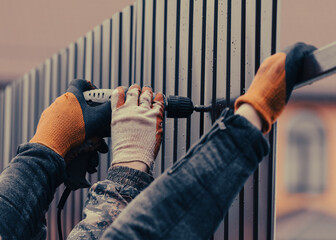A well-installed fence does more than mark property lines. It adds privacy, enhances security, and contributes to a property’s aesthetic appeal. Whether you’re enclosing a backyard, safeguarding a garden, or creating a welcoming front entry, fence installation is a project that blends practicality with design. Understanding the basics of planning, materials, and techniques will help you achieve a result that is both durable and attractive.

Planning Your Fence Project
Every great fence begins with careful planning. Start by determining your primary goal. Do you want privacy from neighbors, a safe enclosure for children and pets, or simply a decorative feature? Your purpose will guide your choices in height, style, and material.
Sketch your property layout and mark where you want the fence to go. Consider slopes, trees, gates, and other features that might affect installation. Taking precise measurements now will help you estimate materials and costs later.
It’s also wise to check any local regulations or homeowners’ association guidelines that might affect your fence’s height or placement. A little research up front can prevent expensive mistakes down the line.
Choosing the Right Material
The material you select influences not only the fence’s appearance but also its longevity and maintenance needs. Common options include:
- Wood – Classic and versatile, wood can be painted, stained, or left natural. It offers warmth and a traditional look but may require regular maintenance to resist weathering.
- Metal – Materials like steel or aluminum provide strength and durability. These fences often have a sleek or ornamental appearance and require less upkeep than wood.
- Vinyl or Composite – These synthetic materials mimic the look of wood while resisting rot and fading. They’re low-maintenance and long-lasting but may come at a higher initial cost.
- Chain Link – Practical and budget-friendly, chain link fences excel at security and function but may lack decorative appeal unless combined with privacy slats or landscaping.
Selecting the right material depends on your climate, budget, and desired style.
Preparing the Site
Before digging any holes, locate underground utilities to avoid damaging pipes or cables. Clear the area of debris, plants, or rocks along the fence line. Mark the location of posts with stakes and string to visualize the finished layout.
Establishing a straight, level line at this stage ensures your fence will look professional when complete. This preparation also makes installation faster and more accurate.
Installing Fence Posts
Fence posts are the backbone of your structure. They provide stability and support for panels or rails, so it’s essential to set them properly.
Dig holes that are deep enough to anchor the posts—typically about one-third of the post’s length—and slightly wider than the posts themselves. In areas with frost, deeper holes may be necessary to prevent shifting during freeze-thaw cycles.
Place each post in the hole, making sure it’s plumb (vertically straight), then fill with concrete or tightly packed gravel. Allow sufficient curing time before attaching rails or panels. Taking care with this step will ensure your fence stands firm for years.
Attaching Rails and Panels
Once the posts are secure, you can attach horizontal rails or panels. The method depends on your fence type. For wood fences, rails are usually nailed or screwed to the posts before vertical boards or pickets are added. Vinyl and metal fences often come with pre-assembled panels that slide into brackets or grooves.
Maintain consistent spacing between boards or panels for a uniform appearance. Using a level helps keep everything straight as you go. For added visual appeal, consider decorative tops, latticework, or caps on posts.
Incorporating Gates
Most fences require at least one gate for access. Plan its location early, ideally in a convenient and level spot. Gates should be slightly wider than expected traffic to accommodate lawn equipment, strollers, or wheelbarrows.
Install sturdy hinges and latches that can withstand repeated use. For security, consider locks or self-closing mechanisms. Reinforcing gate posts with extra concrete or bracing prevents sagging over time.
Considering Style and Design
A fence can be more than a barrier—it can also complement your property’s style. A tall, solid fence offers privacy and a modern look, while a lower picket fence creates a friendly, traditional charm. Mixing materials—such as wood panels with metal posts—can achieve a contemporary aesthetic and add durability.
Color choices also matter. Natural finishes blend with the landscape, while painted or powder-coated surfaces make a bold statement. Coordinating your fence with your home’s exterior or landscaping ties the entire property together.
Maintaining Your Fence
Even the best installation needs occasional care. Inspect your fence periodically for loose boards, rust spots, or leaning posts. Tighten fasteners, repaint or reseal wood as needed, and trim vegetation away from the base to prevent moisture buildup.
Regular maintenance not only extends the life of your fence but also keeps it looking fresh and inviting. Addressing small issues early can prevent costly repairs later.
Hiring Professionals vs. DIY
Many homeowners tackle fence installation as a do-it-yourself project. It can be rewarding and cost-effective if you have the right tools and time. However, large or complex fences may benefit from professional installation. Experienced installers can handle challenging terrain, ensure proper alignment, and complete the job quickly.
If you choose to DIY, research your chosen materials and methods thoroughly. Gather all necessary tools—post-hole diggers, levels, string lines, and saws—before starting. Having a clear plan reduces stress and mistakes.
Bringing It All Together
Fence installation blends practicality with personal expression. By carefully planning your layout, selecting appropriate materials, and mastering installation techniques, you can create a fence that enhances security, privacy, and curb appeal.
Whether you build it yourself or hire experts, a well-designed fence frames your property, protects what’s important, and reflects your taste. With thoughtful design and proper maintenance, it becomes more than just a boundary—it’s a lasting feature that adds value and beauty to your home.